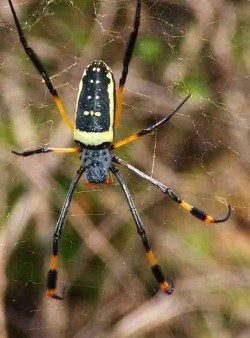
Mala Mala and Kruger National Park, South Africa— Spiders were an everpresant danger to a number of our safari group, to the extent that they’d rather lose a leopard we were tracking than drive through the web of a golden silk orb weaver spider. Conversely, other members of the group designated one of our four Range Rovers “the bug car,” devoting significant time to examining insect and reptile life under rocks and logs.
The golden silk orb weaver spider
The golden silk orb weaver spider spins its web between two trees or shrubs—seemingly every two trees or shrubs in the bush. So plowing through its webs was unavoidable on our off-road hunts. Our vehicles, lacking windshields, had only an antenna to break the webs—and our faces, of course.
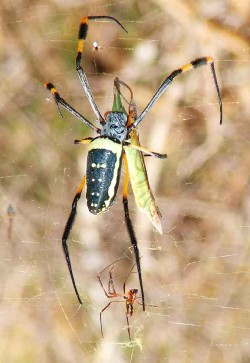
The screams and wails of the fearful ones were a contrast to their calm excitement five feet from hungry lions, a yard from a hunting leopard. One of the arachnophobes easily handled a six-inch millipede, and tasted a fried grub. I guess for some, spiders are just directly hot-wired to the ick response, and no logic applies.
The golden orb spider is a large, striking arachnid that spins an impressive web of strong yellow silk. Its main bridge line can span 30 or more feet, and feels like fishing line. African kids wrap and roll it into yellow rope bracelets.
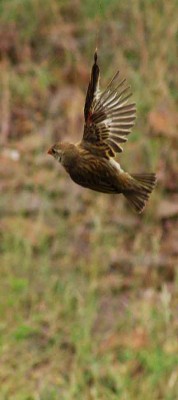
Twice, we came upon a bird caught in a web, flapping helplessly. Caving in to pleas from some of our group, our rangers, two different ones, freed the birds. Yes, they’d otherwise be spider dinner.
The web is so strong and sticky that fishermen use it to make nets. They bend a branch into a teardrop shape and wave it back and forth through the golden silk orb weaver’s web.
Despite those who scream eek, we drove through hundreds of webs. Only a few spiders got into the vehicle. None clamped onto anyone’s face. None climbed into anyone’s shirt. Etc.
Instead, most of the victimized spiders ran into the shrubs at one end of their bridge lines. They would then eat the silk of their ruined webs and spin new ones with recycled material within hours.
See some images of fabric made from the undyed silk of the golden silk orb weaver spider.
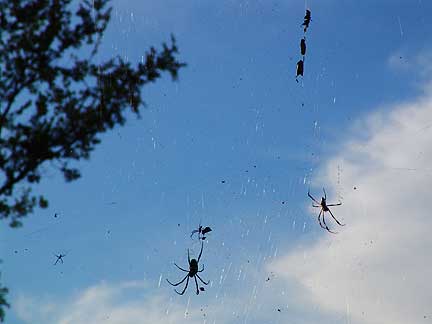
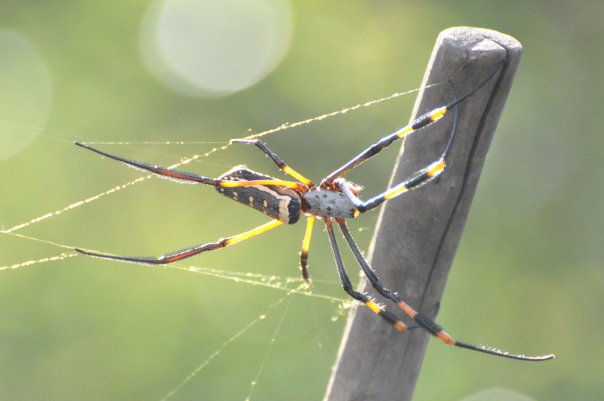
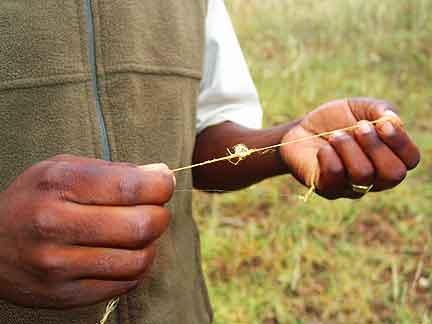
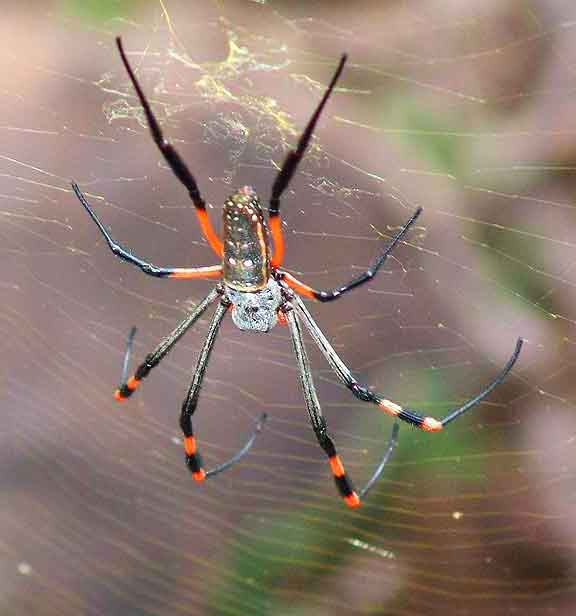


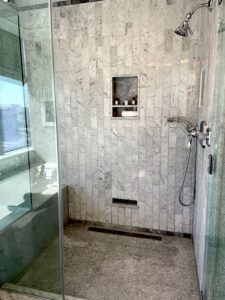
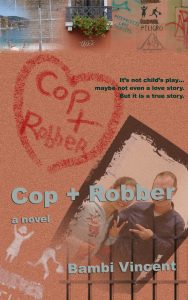
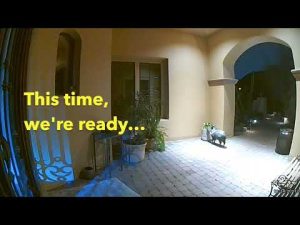
15 Comments
Hi
I came to this sight hoping to identify a light grey spider, with no web, terrorising us from my lounge wall. He/she is the same size – if not larger – than the yellow orb spider.
I was privileged to have a yellow orb spider in my small garden in Highlands North for 3 months. – Then a smaller darker spider resided with her for a week or two. Then her food pile (of bees) suddenly tripled in size, and the visitor was gone! A week or so later she disappeared for a few days, and I later discovered balls of eggs hidden behind a board. Then my husband killed her! I was devastated. A month later I found a minute replica of mom, I thought I should keep it in a box or something until it gets bigger. I decided to leave nature alone, and it was probably gobbled by a lizard. I do miss them and wonder how they came to my small garden when my dad has a large garden with lots of trees.
Should I relocate the spider in my lounge – or show it to my husband?
Thank you, Dr. Lenny Vincent, arachnologist and professor at Fullerton College!
You are right. A slight breeze can pull a silk line out of the spider’s spinnerettes until the line contacts a substrate. At that point the spider pulls the line taut and reinforces it (now called a frame thread). The spider then puts out radial threads followed by a temporary spiral from the center out. Next the spiders constructs its permanent and sticky spiral from the perimeter of the web towards the center. As it does this, it eats the temporary spiral.
Thank-you Bambi and all correspondents, your photos and notes are most interesting. Here in the Bosveld (we’re ~100km west of Thabazimbi) we too have a great many Golden Silk Weavers, perhaps not quite as large as those in the Kruger Park but equally fascinating all the same. Owing perhaps to the generally more sparse foliage here ours seem to spin their webs slightly higher in the air than do those at Kruger; a person on foot here can usually duck quite easily beneath the webs. The trick of course is to remember to do so! I am especially fascinated by just how the Weavers START their webs – HOW does the little guy lay that very first strand, several metres off the ground between the foliage of two trees several metres apart? I think he (well, she) probably extremely cleverly uses the wind – perches on the end of a twig of a suitable tree; waits patiently for when there’s a steady breeze flowing in the right direction; then spins four or five metres of silk to waft gently away into the breeze, until the further end of it touches the tip of a convenient twig on another tree and magically just STICKS there??! Our intrepid arachnid then crawls along this hefketting-to-be a bit like a trapeze artist (the eight legs instead of just two lending a certain advantage, to be sure!) to securely tie the delicately-held strand to the other side before getting on with the task of constructing the web proper. Amazing!! – how truly wonderful is God’s kingdom!
Do you live in South Africa, Katherine? These spiders are gorgeous, but their webs are not nice to walk into—or drive into!
I found one attached to the brick on our garage. She was large and brightly colored….getting ready to lay eggs, I think. I didn’t know if she was harmful to humans so I took it to the woods near our home. I watched her for three days while she constructed her web. It was getting dense and white in the middle.
I had one in my back yard last summer in San Diego. I loved it and visited with it every day. When I would get close it would sort of lower it’s abdomen so you couldn’t see it as well, and raise it’s head. It then looked like a lizard’s head looking at me. It was a bit scary. I assume it is protective cammouflage. It would also keep it’s back two and forward two legs together on each side. I have a bit of arachnophobia, have worked on it and it’s not as bad these days, so this spider’s affect on me was surprising.
I am terrified of spiders and when this “little” critter made its web right outside my kithen window, I almost freaked. My husband, John, and our children were very pleased and excited about the new tenant.
What an astounding story! I remember the size of those webs, and the size of the spiders as well. But I never dreamed that fabric could be made from the webs. Amazing.
Lustrous golden cloth made from undyed silk. Spectacular exhibit of golden orb weavers’ fabric at the American Museum of Natural History.
What magnificent samples of the Golden Orb-Weaver (Nephila clavipes). Poor tourists, I bet they dreamt of the large spiders in their large webs. I have a lady like this in my back yard and every now and then I just watch her do her thing. Pitty mine doesn’t have a boyfriend.
These spiders are also in abundance in Sandveld Nature reserve Free State.
Good story. Too bad the web does not show in the photo of the trapped bird. Maybe photo shop could bring it out.Re. the comment above: only one small group of wolf spiders make webs. Most just hunt on the ground. I’ve never seen a wolf spider on a wall. Bet it was some other type of large spider.
Great story! I will pass it on to all my arachnophobic friends. Sort of bragging rights for what I endured!
Same size as the wolf spiders we had in Suriname, but I don’t know where the wolf spiders made webs. We’d see them on the walls inside our house. Killed them with machete until we realized they ate the mosquitos, etc. Good spider…